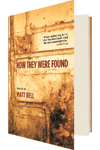As the stories in this debut collection add up, so do the bodies, people done in by diverse, often fantastical methods and accidents: drowning, freezing, crushing, knifing, shooting, suffocation, disease, traps, saws, dismemberment, exposure, and more. Then there are the disappearances: a cartographer’s sick girlfriend vanishes, a homunculus starts shrinking. The comparatively few characters who remain alive and present are preoccupied with others’ annihilations. A man finds a drowned girl in the local lake, and, obsessed with the corpse (“her long blond hair, wrecked by the pond’s amphibian sheen” and “her lips, blue where the lipstick’s been washed away, flaky red where it has not”), he takes her home to his meat freezer. Now his life, too, begins to stink of death.
Body toll notwithstanding, How They Were Found is anything but bleak. For one thing, there’s the prose: generous, urgent, rhythmic. Above all, rhythmic. “Artie Matthews will find him buried beneath a deadfall of trash ten feet from where his brother died and wonder why he didn’t yell, why he didn’t ask Homer for help. Artie Matthews will not realize that Langley did yell, did howl, did scream and cajole and beg and whimper.” Bell’s use of anaphora is so pervasive that it could quickly become overuse if it weren’t for the fact that form follows function, his rhetorical repetitions echoing the events and obsessions on the page. In “The Cartographer’s Girl,” for instance, a cartographer tries to find his vanished girlfriend by compulsively mapping and remapping the city in which they’d been living together. He’s tormented “by her absence, by not knowing where she went, by not knowing a sure way to follow.” Striving not to miss any part of the city where she might have disappeared, his maps become ever more detailed, down to the level of the interior of the local bar, where he “draws topological renditions of the layout of the tables, of the path from his stool to the bathroom, of the distribution of waitresses or couples or smoke.” Here, the recurring prepositions (those bys, those ofs) mimic the repetitive nature of the task the cartographer has set for himself as he circles the city.
“Wolf Parts” involves another kind of recurrence, retelling again and again in brief vignettes the story of Little Red Riding Hood. In one version, the grandmother eats the wolf from the inside out. In another, the wolf strips the girl of her clothes, and she rides on his back into the woods. In yet another, Red ties the wolf up and cuts him into pieces. But the most telling vignette is the first one, in which every time the girl gets out of the wolf’s stomach she finds herself back en route to her grandmother’s house, headed for danger: “After Red cut her way out of the wolf’s belly—after she wiped the gore off her hood and cape, her dress, her tights—she again found herself standing on the path that wound through the forest toward her grandmother’s house.” The characters can’t escape their myth; the story outlasts its participants.
As the collection continues and the deaths and disappearances pile up, it becomes increasingly clear that, in the various microcosms of How They Were Found, only the tales the characters leave behind can survive their fleeting lives. Even in “Dredge,” the story featuring the drowned girl, it turns out that what her keeper really needs from her corpse is the story of her life and how she died. He won’t find it, but in the meantime we have his story, and it’s a gift that may last.
—Reese Okyong Kwon





